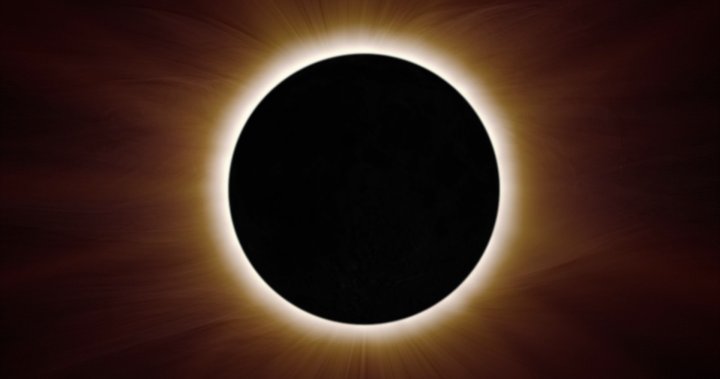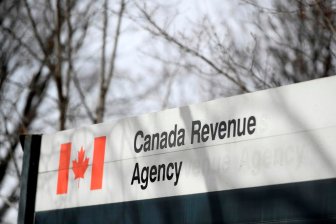As a once-in-a-lifetime solar eclipse closes in on portions of eastern Canada, several cities across Ontario, Quebec and New Brunswick are gearing up for an influx of sightseers that plan on standing in utter darkness across the path of totality on April 8.
The celestial event will first hit Ontario from the south just before 2 p.m. EDT on Monday and depart Newfoundland just after 5 p.m. EDT, or 6:30 p.m. NDT.
Hot spots like Niagara Falls and Kingston, Ont., Montréal, Que., and Fredericton, N.B., will get maximum coverage with some experiencing it for as long as three and half minutes as the moon passes between the sun and Earth.
Should weather conditions cooperate, provincial and local police services are bracing for packed roadways and potential bumper-to-bumper traffic.
Here’s more on what to expect at the most popular spots hosting viewing events.
Expected Maximum Totality (maximum coverage of the sun): 3 mins. 43 secs. between 3:18 p.m. to 3:21 p.m. EDT
Fort Erie, Ont., will be the Ontario municipality with the best sightline for the path of totality, equating to the longest time under darkness: close to four minutes.
The northeastern shores of Lake Erie and southeastern Niagara Peninsula will also have totality lasting three-plus minutes.
The last time Fort Erie area saw a solar eclipse was in 1925 and another one won’t be back until 2144.
Expected Maximum Totality (maximum coverage of the sun): 1 min. 47 secs. between 3:18 p.m. to 3:20 p.m. EDT
Breaking news from Canada and around the world
sent to your email, as it happens.
Hamilton, Ont., will be right on the north edge of the path and will see the first piece of the moon’s shadow just before 2:04 p.m. and experience totality at 3:18 p.m. for about two minutes.
Hamilton has designated four large parks, some conservation areas and Tim Hortons Field as ideal viewing sites. While an numeric estimate is not available, a city official said “large crowds” are expected and, as of Friday, all of the 10,000 allocated seats at Tim Hortons Field had been accounted for.
Another total eclipse will not be seen in Hamilton for another 120 years.
Expected Maximum Totality (maximum coverage of the sun): 3 mins. 32 secs. between 3:18 p.m. to 3:21 p.m. EDT
The eclipse will begin its partial phase in Niagara Falls, Ont., at 2:04 p.m. Monday and hit totality at 3:18 p.m. lasting about three and a half minutes.
In January, National Geographic tagged the spot as the “most picturesque” place to view the eclipse with ideal vantage points and the “iconic waterfalls thundering in the background.”
With the city being a reasonable distance from half the population of North America, the spot is an attractive location that could potentially draw in hundreds of thousands of visitors.
The last time Niagara Falls saw a solar eclipse was in 1925 and another one won’t be back until 2144.

Expected Maximum Totality (maximum coverage of the sun): 2 mins. 52 secs. between 3:22 p.m. to 3:23 p.m. EDT
Kingston, Ont., will see the first partial phase of the event at 2:09 p.m. on Monday with the path of totality arriving at 3:22 p.m. lasting just under three minutes.
Between 70,000 and 500,000 people are expected to travel to the community of about 170,000, depending on the forecast.
Residents have been asked to avoid driving on Monday and planned road-closures will be in effect to make sure routes to the hospital remain open.
Expected Maximum Totality (maximum coverage of the sun): 1 min. 26 secs. between 3:26 p.m. to 3:27 p.m. EDT
Montréal, Que., will also be right on the north edge of the path of totality with a partial phase beginning at 2:14 p.m. on Monday before making it to total darkness just before 3:27 p.m. lasting about a minute and a half.
The city’s Espace pour la Vie, which consists of five natural museums has teamed up with Parc Jean-Drapeau to host what could be up to 80,000 people.
According to the city, the last total eclipse in Montréal happened in 1932.
Other Quebec municipalities in the path of totality include Sherbrooke, Lac-Mégantic, and Cap-aux-Meules with the total solar eclipse taking place between 3:25 and 3:40 pm. depending on the region.
Expected Maximum Totality (maximum coverage of the sun): 2 min. 12 secs. between 4:33 p.m. to 4:35 p.m. ADT
The first sighting in Fredericton, N.B., starts with a partial phase emerging 3:23 p.m. local time on Monday with the path of totality checking in at 4:33 p.m. lasting just over two minutes.
Other areas that will experience 100 per cent totality include Woodstock, Florenceville-Bristol and Miramichi.
Each of those venues will see the sun’s light covered by the moon for just over three minutes.
— With files from Global News’ Shane Gibson, Annabelle Olivier and Rebecca Lau.
© 2024 Global News, a division of Corus Entertainment Inc.










